No-Till Farmer
Get full access NOW to the most comprehensive, powerful and easy-to-use online resource for no-tillage practices. Just one good idea will pay for your subscription hundreds of times over.

MOVING FAST. Precision Planting’s SpeedTube seed delivery system plants corn on strip-tilled ground near El Paso, Ill. Faster planting speeds are attainable in no-till and strip-till systems, but conditions and machine setup are major factors, experts say.
When planting season arrives, time is money — and it’s clearer than ever that no-tillers and strip-tillers are facing a tightening window to get their crops in before yield potential is lost.
Experts say the predictable, rain-fed cropping systems that Corn Belt farmers were used to have been replaced by unpredictable, soaking spring rainstorms that can make timely planting very difficult.
Paired with a trend toward larger farms, this high-stakes waiting game is fueling demand for bigger and faster planters that can help growers get more acres covered in a narrowed time frame.
New planter technology unveiled recently could help no-tillers and strip-tillers hike their planting speeds to 7-10 mph, nearly double the norm.
But is it a good idea?
Representatives from Kinze Mfg., John Deere, Precision Planting and Horsch touch on how growers might find success.
Data from Purdue University ag economist Ben Gramig shows that since 1980, there have been significant changes in mean weekly planting days for growers in the Corn Belt.
From 1980-1994, Illinois, Indiana, Iowa, Kansas and Missouri all had between 4.18-4.89 weekly planting days, according Gramig’s analysis of USDA data.
But from 1995-2010, Indiana dropped from having the most planting days (4.89) to the least at 3.72 days, and Iowa and Illinois also lost half…